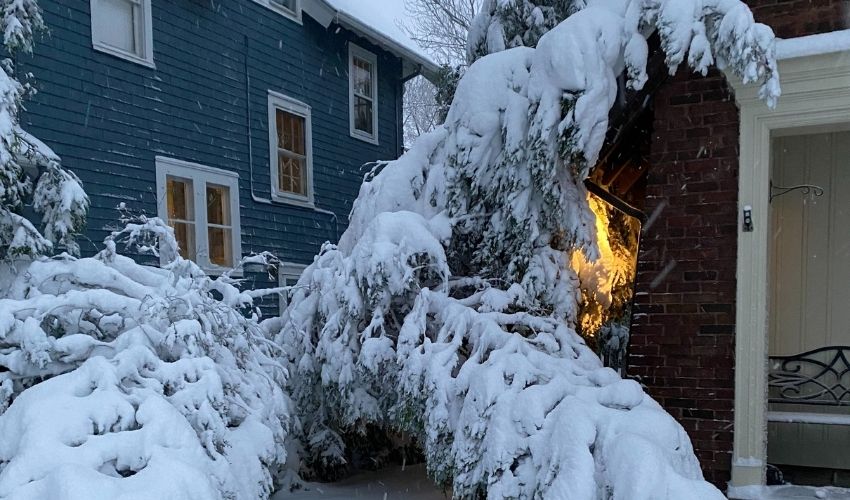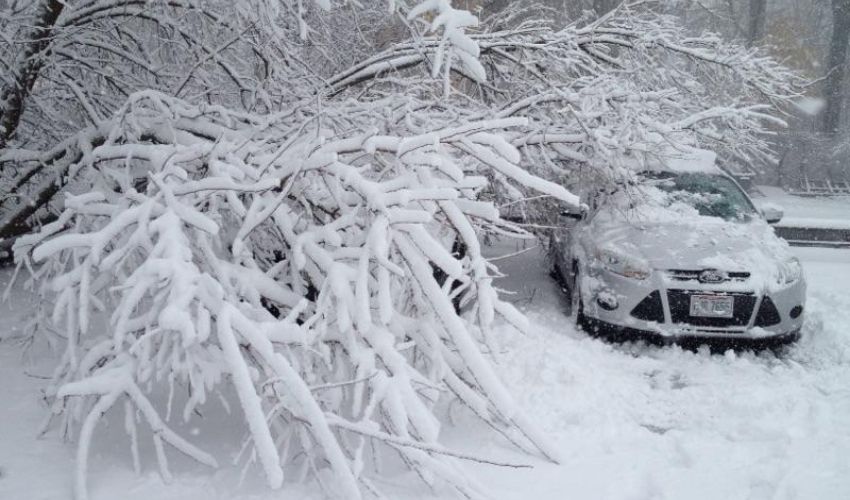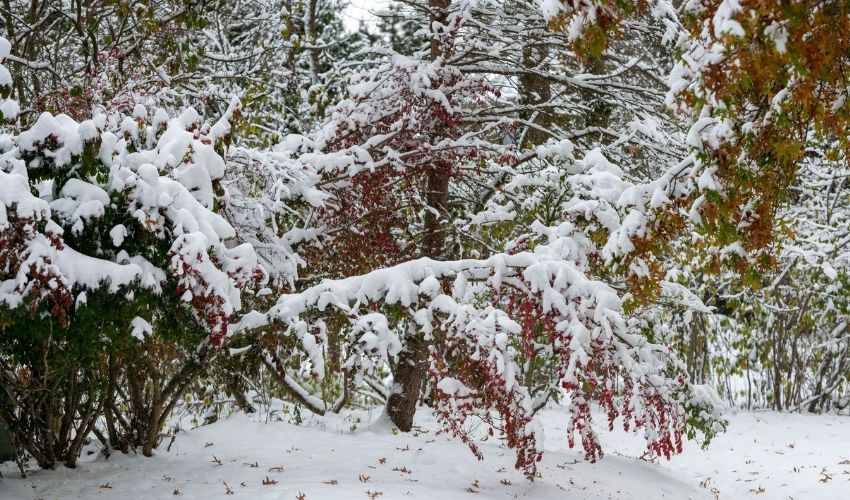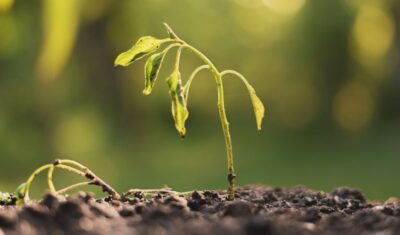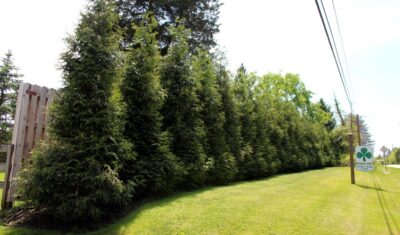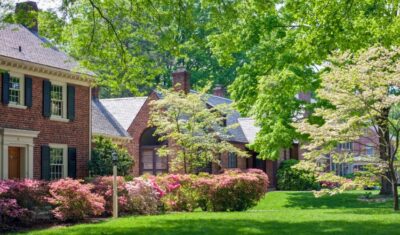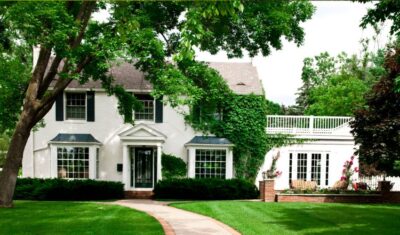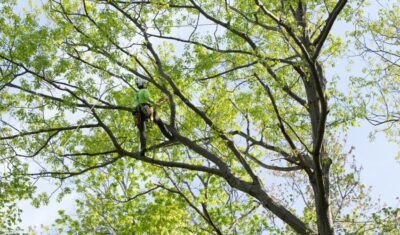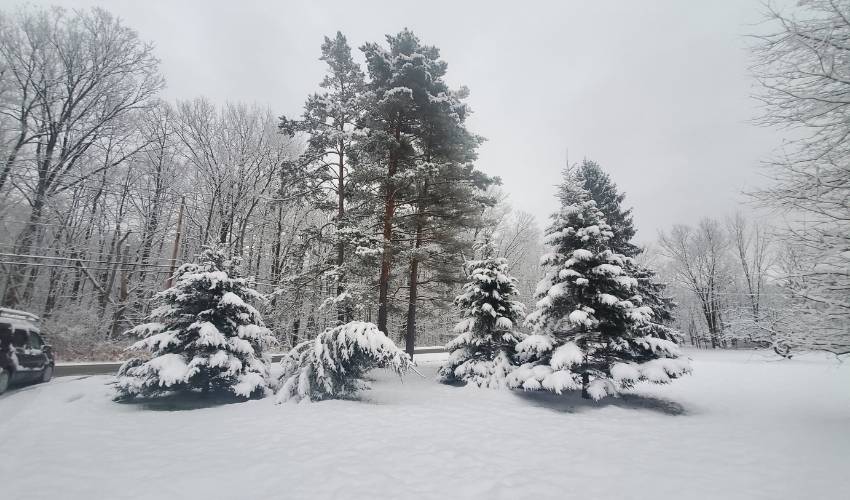
Winter weather in northeast Ohio often brings heavy snow, freezing rain, and icy conditions. After a snowstorm, we frequently get calls about trees that have bent over or broken from the weight of snow or ice. Sometimes, people call about a leaning tree, or broken branches hanging in the tree canopy, or trees whose branches are bowed right down the ground. Heavy snow and ice loads can cause a wide range of damage to trees and shrubs!
Can You Fix Bent Over Trees?
Whether or not you can repair your trees after winter snow and ice damage depends on so many variables that it’s difficult to give a single, definitive answer.
So, in this article, we cover what you need to know about dealing with snow and ice-damaged trees or shrubs, plus how to prevent snow and ice damage in the first place. You’ll find details on:
- Trees and shrubs at greatest risk of snow and ice damage
- What to look for after heavy snow or freezing rain
- How to evaluate whether or not the damage to your trees is serious or dangerous
- What to do when branches are bent under the weight of snow or ice
- When a damaged tree can be saved and how to do that
- How to repair a snow or ice damaged tree, including broken branches, bent or bowed branches, or a leaning tree
- When to call an arborist to assess your tree(s)
Trees are designed to withstand winter weather, but sometimes conditions are too severe for them to endure. After a storm clears, you may find that your trees have been battered and need some help. Read on to learn more.
Trees & Shrubs Commonly Bent or Broken by Ice & Snow
Some trees and shrubs are more prone to damage from ice and heavy snow.
The ones we commonly see bent to the ground in our area include evergreen shrubs like arborvitae, yew, and juniper, as well as birch trees. Deciduous shrubs with long branches, such as forsythia, also get bowed down, especially when coated in ice.
Other trees have brittle wood or branch structures that make them more vulnerable to breakage from the weight of snow or ice. These include elm trees and Bradford pears, among others.
However, any tree or shrub, of any species, can break or bend as a result of snow and ice build-up. It’s important to recognize that no tree or shrub is safe if the snow and/or ice piles up too much.
Signs of Snow and/or Ice Damage on Trees and Shrubs
Some types of winter damage are easy to spot –
- Branches bowed to the ground
- Broken branches, either on the ground or hanging in the tree
- Torn off branches and bits of bark
- A tree or shrub that has split apart
- A leaning tree
- A flattened shrub
But other snow and ice damage isn’t as easy to see. Cracks and splits in tree branches or narrow crotches can be difficult to identify (unless you know exactly what you’re looking for). Damaged or loosened cables or bracing can be similarly difficult for a homeowner to recognize. That’s why it’s so important to have a certified arborist examine any trees that have been visibly damaged, as well as those that haven’t.
Tree Damage From Winter Snow and Ice
Branches, both large and small, are naturally flexible, allowing trees and shrubs to bend and move with winter winds and the weight of snow and ice. But in winter, cold or freezing temperatures make branches stiffer and more brittle – and more likely to break, bend, or fall when covered with a heavy load of snow or ice. Winter snow and ice can also pack into every nook and cranny of your tree’s crown, making it heavier and potentially destabilizing the tree.
What to do with Broken Branches
When a branch is torn off from the weight of snow or ice, it leaves a jagged, irregular, open wound in the tree’s protective bark. These wounds can be small or gaping, depending on the branch’s diameter and how strongly it’s attached to the tree’s trunk. Larger branches can also tear off the bark on the tree trunk and rip off other branches as they fall.
Branches that break further out from the tree’s trunk often remain attached, with their broken-off ends dangling or entangled in other branches. A tree branch that breaks can also take down other branches as it falls, compounding the damage.
Here are some general guidelines for dealing with snow damaged branches:
- If the branches are on the ground, check the rest of the tree’s crown for any other broken or dangling branches–from a safe distance.
- Don’t stand beneath a damaged tree, and don’t try to pull down broken branches with a rake or pole pruner. Besides dumping a load of snow down the back of your shirt, snow- or ice-loaded branch can fall on your head and injure (or even kill)you.
- If it’s safe, you can drag broken branches that are on the ground to a place where they don’t block pedestrians or cars or create a new hazard.
Please, please don’t try to climb the tree to remove broken branches yourself! Most people assume that winter storm injuries occur during the storm, but the reality is that most injuries happen afterward when people are trying to clean up the damage. A snow- or ice-covered tree is slippery, may have hidden defects that will fail when you put more weight on them, and often reacts in unpredictable ways when you cut or pull on branches.
What to do with Branches Bent by Snow or Ice
The usual advice for handling branches bent under the weight of heavy snow or ice is to leave them alone. As the snow or ice melts, most branches will slowly straighten on their own. Do not try to knock ice or heavy snow off the bent branches – they’re more likely to break, leaving a jagged, unsightly stub.
However, if the branches are encased in ice or trapped by heavy snow on the ground, they may stay bowed over for too long and lose their natural shape. In these cases, wait until the growing season is well underway. As sap starts to flow and leaves emerge, the branches may start to straighten on their own.
If branches don’t straighten out by summer, give us a call. There are some things we can do to help the tree recover (see below).
Of course, if the branches are bent over a walkway or driveway and are blocking access, you may want to have them professionally pruned off right away. This is not a DIY job! Branches that are under stress from heavy loads can break or spring back unexpectedly, causing serious injury. This is definitely a pruning job to leave to a certified arborist.
Depending on the number, placement, and size of bent branches that need to be pruned to allow access, we may instead recommend removing the tree entirely. Pruning off too many branches can permanently disfigure a tree and make it vulnerable to pests and diseases. In that case, it’s better to cut down the tree and plant a replacement in spring.
What to do with Leaning or Broken Trees
A large tree that is leaning or has a broken trunk or main leader is more serious and should be dealt with carefully.
- Do not go near a broken or leaning tree (and don’t try a DIY fix!), as it’s unpredictable. And if it’s caught in overhead utility lines, it’s extremely dangerous. Not to mention that ice and snow can fall at any time, as can the tree itself.
- If the broken tree is leaning over or blocking a sidewalk or public road, call your city’s public works or emergency department to ask for help.
- If the tree is on your property, call a professional tree care company for assistance and evaluation.
How to Repair Snow or Ice Damage on Trees and Shrubs
The right way to fix snow or ice damage depends on the tree and the type and extent of the damage.
Corrective Pruning
Corrective pruning may be enough to save a tree, large or small, by removing damaged branches and balancing the remaining crown structure. This work doesn’t have to be done immediately, as long as it’s done before trees start growing in spring. Give us a call now to schedule a consultation so you don’t forget!
Cabling and Bracing
For a large tree, cabling and bracing can stabilize the tree and keep its branches from further breakage.
This work must be done by trained professionals, as it requires an understanding of tree structure and physics. Plus, there’s always the possibility of the tree breaking further or falling over, making the work dangerous or even lethal.
It’s important to regularly inspect any cables and braces in trees. Over time, they need to be adjusted as a tree grows and shifts, and as the bracing hardware shifts or stretches. Both decaying wood and failing hardware can further damage the tree or make it more dangerous to anything or anyone within the range of a snapping cable or falling limb. Sometimes a tree stabilized with cables will live but slowly decline instead of continuing to grow.
Staking a Leaning Tree
A leaning tree of any size suggests that beneath the soil, the tree’s root system has been damaged. This type of damage can’t be evaluated just by looking at the tree. If it’s serious, you’ll need an arborist with specialized equipment to investigate.
- For a small tree that’s leaning, stakes and flexible ties may be enough to stabilize it and prevent further damage while the tree re-establishes itself. Roots will regrow and stabilize the tree over the course of several growing seasons.
- If the root damage is extensive, the tree may not recover. Roots left in tension, where the weight of the leaning tree pulls on them, can be damaged beyond repair.
Removing a Damaged Tree
A severely damaged root system can’t support a living tree for long, and a leaning, unstable tree is dangerous. Sometimes, large branches obstructing traffic or access to your home cannot be pruned without compromising the stability, appearance, or health of the tree. Sometimes, removing the tree is the only option.
Because of their size and structure, trees can cause the most damage during or after a snowstorm. It’s worth re-stating that a tree is a hazard if there is anything or anyone within the range of its falling that can be damaged, injured, or killed. If the tree is on your property, you can be liable for any damage.
But, if your damaged or leaning tree is remote and nowhere near roads, sidewalks, utility lines or boxes, or neighbors, you can leave it to its own devices. Damaged and dying trees that are not a hazard to people or property can benefit wildlife and return nutrients to the soil as they decay.
In the Spring
Many trees that were damaged in winter will benefit from a spring fertilization program. Deep root fertilization puts essential nutrients and soil conditioners directly into the soil near the tree’s roots. This allows the tree to quickly absorb the necessary nutrients, giving it the extra energy it needs to repair damaged wood and heal broken or pruned areas.
LEARN MORE > How late spring snow affects trees
When to call an arborist to assess your snow-damaged tree
You should call a certified arborist to assess any damage that is greater than a small leaning tree that you can stake and brace yourself, or a branch that you can prune from the ground (after snow and ice have melted off the branch!).
A professional arborist will tell you what steps need to be taken and the likely results. If corrective pruning can be done to repair a damaged tree, an arborist will tell you. But if an arborist tells you that a tree is a hazard and beyond saving, listen closely. Arborists are concerned with the health and safety of trees and won’t do any tree work that will further damage the tree.
And if someone offers to top your tree to remove the damage, don’t go for it. Topping is the worst thing you can do to a tree, and certified arborists won’t do it.
LEARN MORE > Proper pruning techniques.
How to Prevent Trees & Shrubs from Bending or Breaking from Snow Loads
Before Winter Storms
The best way to stop trees from bending or breaking is to keep your trees properly pruned to ensure a balanced crown. Professional pruning also helps the tree develop a strong scaffold, or arrangement, of branches that taper from large to small as they grow out from the main trunk.
It’s particularly important to have regular inspections for large or mature trees. An arborist will look for structural weaknesses, damage, or decay that’s too high up to see from the ground, as well as insect infestation or disease. Finding potentially fatal problems early is key to keeping a mature tree living.
During Winter Storms
During a snowstorm, you can try to gently brush snow off branches with a soft broom. Don’t whack at the branches or use a hard tool like a rake; you’ll just break off more branches.
Go out every few hours to brush snow off ornamental trees (anything you can reach from the ground) and shrubs. You can also give shrubs a gentle shake to dislodge snow. By doing this, you’ll prevent snow from building up to the point that it breaks branches or bends them over.
We do not recommend doing this during an ice storm or freezing rain. The ground slippery (putting you at risk of injury) and you won’t be able to knock the ice off trees or shrub branches. Shaking them will just end up breaking brittle branches and doing more damage.
If You Need a Hand
Heavy snow and thick layers of ice can quickly damage trees and shrubs. The best way to help them withstand winter weather is to keep them healthy through regular inspections, professional pruning, and a tree health care program. Large, mature trees not only increase your property value, but also provide immeasurable value to the environment, native wildlife, migrating birds, and beneficial pollinating insects. Why put all of that at risk from winter weather?
If you need to have your trees pruned, staked, or just evaluated after snow or ice, our certified arborists and experienced crews are just a phone call away. We do nothing but care for trees, and we’d love to care for yours, too.
We Can Help!
If your trees or shrubs were damaged by winter weather, contact Independent Tree. We can prune off damaged branches, check for problematic issues, schedule fertilization services, remove dead trees, and more!Recent Articles
Topics
About The Author

STAY IN THE LOOP
WITH OUR
LATEST UPDATES
"*" indicates required fields

